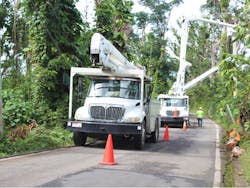The Puerto Rico Electric Power Authority (PREPA) issued a revised integrated resource plan (IRP) late last week in the latest move to redesign the island’s grid to avoid a repeat of the massive power outages brought by Hurricane Maria.
Like its earlier version, the new plan segments the island into eight minigrids but incorporates more renewable energy and storage. The IRP also continues to call for a liquified natural gas import terminal and various natural gas power plants.
Submitted with the Puerto Rico Energy Bureau, the 300-plus page document (RPT-015-19) is being carefully scrutinized by competitive energy companies and organizations who see Puerto Rico’s post-hurricane reconstruction as an opportunity to create a world prototype for community microgrids and renewables.
An earlier version of the IRP was released in March by PREPA, the island’s sole utility. But it was sent back to the drawing board by state regulators who wanted more modeling and analysis.
IRP takes the long view
Now used in more than half the states on the mainland, IRPs are important because they determine the resources utilities will use, creating market signals, often for years to come.
“This is a planning tool for the next 20 years,” said Agustín Carbó, former chairman of the Puerto Rico Energy Bureau and now senior manager at the Environmental Defense Fund. ”If they want to build something not completely sustainable…it is going to be for the long run.”
Carbó and others interviewed by Microgrid Knowledge said they need more time to study the complex plan, released on Friday. But they raised some immediate red flags.
While the IRP appears to favor decentralization in that it breaks the utility grid into eight relatively large minigrids — a design created by Siemens — the utility continues to balk at smaller, community microgrids, according to Carbó.
This runs counter to a government effort to boost microgrid development through new rules. Puerto Rico last year established classes of microgrids, defined types of generation they can use, and clarified the role of utilities and municipalities.
PREPA vs microgrid rules
But PREPA signaled in the IRP that it takes issue with the microgrid rules, and the utility has yet to create a microgrid interconnection process, Carbó said.
“They’re objecting to the current rules that went through a public participation process,” he said. “I’m concerned that the issue could delay approvals of new microgrid systems.”
The utility did not detail in the IRP why it objects to the microgrid rules, Carbó said. But he expects the issue to be teased out in what is likely to be a long discovery and review process before the Puerto Rico Energy Bureau.
Complicating its work, PREPA is a utility in bankruptcy trying to revamp a system destroyed in a hurricane and rebuilt for the short term. In addition, the utility must meet a government mandate of 40% of its electricity coming from renewable energy by 2025 and 100% by 2050.
Roy Torbert, principal for the Rocky Mountain Institute’s islands program, said he is concerned that the plan continues to foster a utility controlled system and lacks focus on incorporating customer microgrids and solar plus storage. Moreover, it fails to consider them as productive resources that can interact with the central grid, he said.
Natural gas versus renewables
The plan should treat all resources fairly, Torbert said. Instead, he says it wrongly places a 16% cost adder on solar. At the same time, the utility does not adequately weigh risk associated with the cost of building new gas fired generation, especially since PREPA’s electricity sales are declining, he said.
EDF’s Carbó added that he understands that natural gas needs to be a transition fuel to maintain power reliability as the island gradually transitions to renewable energy. However, he said if the investment in natural gas is too great and becomes embedded over too many years, it will become the default resource and Puerto Rico will not reach its renewable energy goals.
“The IRP is trying to be aggressive on renewable integration, but there are still a lot of questions, and those will need to be analyzed in detail,” he said.
Puerto Rico’s power supply must be 100% renewable by 2050. Photo by petrmalinak/Shutterstock.com
Value for microgrid developers in Puerto Rico
Isaac Maze-Rothstein, research associate with Wood Mackenzie Power and Renewables, who has been tracking the Puerto Rico market, said he was excited to see the IRP recommend investing $4.89 billion by 2024 in priority 1 and 2 minigrid projects and $1.08 million in controls and related switching
“Given the aggressive timeline, we think there is added value in microgrid developers entering Puerto Rico either by responding to the upcoming RFPs related to these minigrids or exploring customer-sited projects,” he said.
He noted there are already more than 30 microgrid players now working on the island.
“The amount of solar and storage outlined in the plan is also astounding. For context, this plan recommends installing more front of the meter energy storage than has been installed in the entire country between 2013 and Q1 2019,” he said.
PREPA filed the 2019 IRP in January. The new version represents the third draft. The utility plans to provide testimony explaining the plan on June 14. After that, the bureau will rule on whether to proceed or ask PREPA for more revisions. If the plan proceeds, the regulatory authority will set a timeline for review in a process that includes discovery and intervenor comments.
The IRP plan is available on the Puerto Rico Energy Bureau’s website.
Track news about microgrids and minigrids in Puerto Rico. Subscribe to the free Microgrid Knowledge newsletter.







